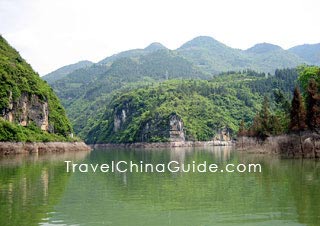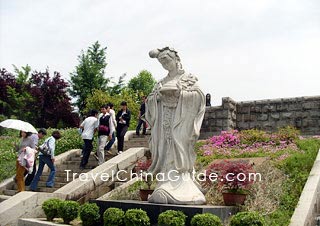Ankang Travel Guide
Ankang Facts
Chinese Name: 安康 (ān kāng)
Population: 2,668,900
Area: 23,391 square kilometers (9,031 square miles)
Location: in the southeast of Shaanxi Province, northwest China
Administrative Division: 1 district (Hanbin); 9 counties (Hanyin, Shiquan, Ningshan, Ziyang, Langao, Pingli, Zhenping, Xunyang, Baihe)
Area Code: 0915
Zip Code: 725000
GDP (2019): CNY 118.206 billion (USD 17.134 billion)
Boasting Fascinating Natural Landscape
Located in the southeast of Shaanxi Province, Ankang neighbors Xi'an to the north, and shares boundaries with Hubei to the east and Sichuan to the south. It is easy to reach Xi’an in 2 hours by bullet train, so a trip to Xi’an after visiting Ankang can be taken into consideration. As Qinling Mountain stands in the north of Ankang and the Daba Mountain cuts through the southern area, Ankang boasts fascinating natural landscapes. Xiangxi Cave and Nangong Mountain National Forest Park are two widely-known natural scenic spots in Ankang. Moreover, Ankang has cultivated a splendid culture in the long history. There are more than 650 historical sites, including ancient relics, ancient temples, cliff carvings and modern cultural relics.
Ankang Attractions - Things to Do
Xiangxi Cave
It is located in the southern suburb of the city with Hanshui River to the north and Bashan Mountain to the south. Covering an area of over 3.9 square miles, the scenic area can further be divided into Xiangxi Cave, Wenwu Mountain, Niuti Mountain, Wugong Mountain and Santian Gate. It is a beautiful landscape with places of cultural interest.
Legend says that Xiangxi Cave was once the place where Lu Dongbin (one of the eight immortals) educated himself, therefore adding a more ethereal flavor to the Cave. Peaks over peaks embrace the sight with clear creek bubbles. It is a fairyland of sweet flowers, fresh grass and rare trees. Elegant towers and pavilions add to the beauty of the area, many of which are historic relics whose first construction started as early as Tang Dynasty (618-907). A huge ladder was built along the mountain. People imagine it is the route for celestial beings to get to heaven.
Every year, Xiangxi Cave attracts many visitors by its charming scenic beauty and classical buildings. It is a paradise for you to return to nature and refresh your minds!
| Entrance Fee: | CNY 40 |
| Opening Hours: | 08:00-20:00 |
Nangong Mountain National Forest Park
It is situated in the east of Langao County, about 92 kilometers (57 miles) from the downtown of Ankang City. It is the first national forest park in Shaanxi Province. Covering an area of about 7,648 hectares (18,899 acres), this beautiful park gathers together hills, waters, rocks, numerous plants and animals. It is famous for its remnants of ancient volcano eruptions and glaciers, virgin secondary forest and a great Buddhist's relics.
This forest park is a natural botanical and zoological garden. There are about 1,800 species of seed plants and ferns, and 300 kinds of wild animals. It is a paradise of endangered plants and rare wild animals, such as Chinese dove trees, trembling poplars, cuckoopints, katsura trees, giant salamanders, golden pheasants, golden eagles and civet cats. One 'must-see' is a thousand-year old oak which rises again, and fourteen saplings of seven tree species grow in its trunk.
As this mountain is at an elevation of about 1,000 meters (3,281 feet) to 3,000 meters (9,842 feet), trees are divided into four clear forest belts there, forming a totally different glorious forest landscape in four seasons.
Since ancient times, this mountain had been a sanctum of Taoism and Buddhism. In 1126, a Taoism temple was built here and gradually evolved into the sacred place of Buddhism. In 1820, a great Buddhist monk died here and his remains were kept for hundred of years, adding mystery to the grand mountain.
The Nangong Mountain also abounds in fantastic caves and craggy rocks, which present an infinite variety of shapes. The waterscape in this national forest park is another 'must-see'. Streams wander through the magnificent mountains and deep valleys; Waterfalls dash down thousand feet as if the Silver River fell from azure sky. About 20 ponds in different sizes and colors are added into this natural world. In addition, this mountain with peaks peeps through clouds and mist. Seen from the summit of the Nangong Mountain, the beauty of the sunrise is beyond description. Nowadays, the Nangong Mountain National Forest Park has become an excellent scenic area for sightseeing, leisure and spending summer.
| Entrance Fee: | CNY 100 (March 1 to November 30) CNY 60 (December 1 to end of next February) |
| Opening Hours: | 08:00-18:00 |
Yinghu Lake
Tips:
1. At the evening of the Mid-Autumn Festival, the park holds an open-air activity for admiring the bright full moon.
2. From April to May, the mountain flames with azaleas. Camping and mountain climbing activities are held here.
3. On June 24th (lunar calendar), it is a Ho Hsien-ku's Birthday. Rich and varied folk activities are held in this national forest park.
| Entrance Fee: | CNY 70 (All-inclusive ticket) |
| Opening Hours: | 08:30-17:00 |
|
|
How to Get to Ankang
1. Ankang Airport is 8.1 kilometer (5 miles) from the downtown area. At present, it only operates flights shuttling from Xi'an with 40-minute flight.
2. Ankang is a four-hour ride from Xi'an by train, and ten hours by bus.
Weather
Having a subtropical continental monsoon climate, Ankang weather is warm but dry in spring, and overcast and rainy in autumn. Summer is rainy but may be attacked by drought, while the winter is chilly, seldom rainy or snowy. Warm springs and cool autumns are the best seasons to visit this place.
Ankang Travel Tips
![]() History:Ancient tribes living in this area were conquered by the Chu Kingdom in the Spring and Autumn Period (770 BC - 476 BC). It was a vital place contested by Qin and Chu kingdoms during the wars in Warring States Period (476 BC - 221 BC), and then it belonged to the Hanzhong Shire, established by the Qin Dynasty (221 BC - 206 BC).
History:Ancient tribes living in this area were conquered by the Chu Kingdom in the Spring and Autumn Period (770 BC - 476 BC). It was a vital place contested by Qin and Chu kingdoms during the wars in Warring States Period (476 BC - 221 BC), and then it belonged to the Hanzhong Shire, established by the Qin Dynasty (221 BC - 206 BC).![]() Physical Features: Ankang lies at the north foot of Daba Mountain, south of the Qinling Mountains. The Han River flows through the city from west to east. Its highest point is in the eastern part of the Qinling Mountains with an altitude of 2,965 meters (9,728 feet), while the lowest is in the outlet of the Han River from the city's territory, only 170 meters (558 feet) above the sea level.
Physical Features: Ankang lies at the north foot of Daba Mountain, south of the Qinling Mountains. The Han River flows through the city from west to east. Its highest point is in the eastern part of the Qinling Mountains with an altitude of 2,965 meters (9,728 feet), while the lowest is in the outlet of the Han River from the city's territory, only 170 meters (558 feet) above the sea level.![]() Special Local Products: green tea, winter peaches
Special Local Products: green tea, winter peaches

